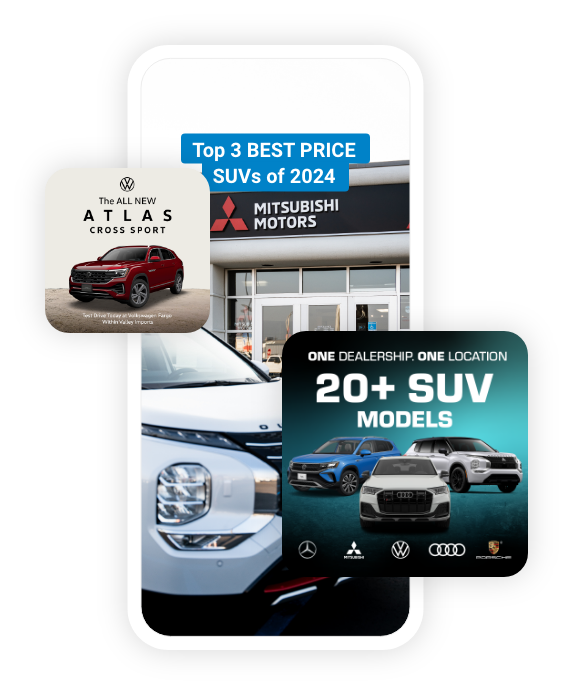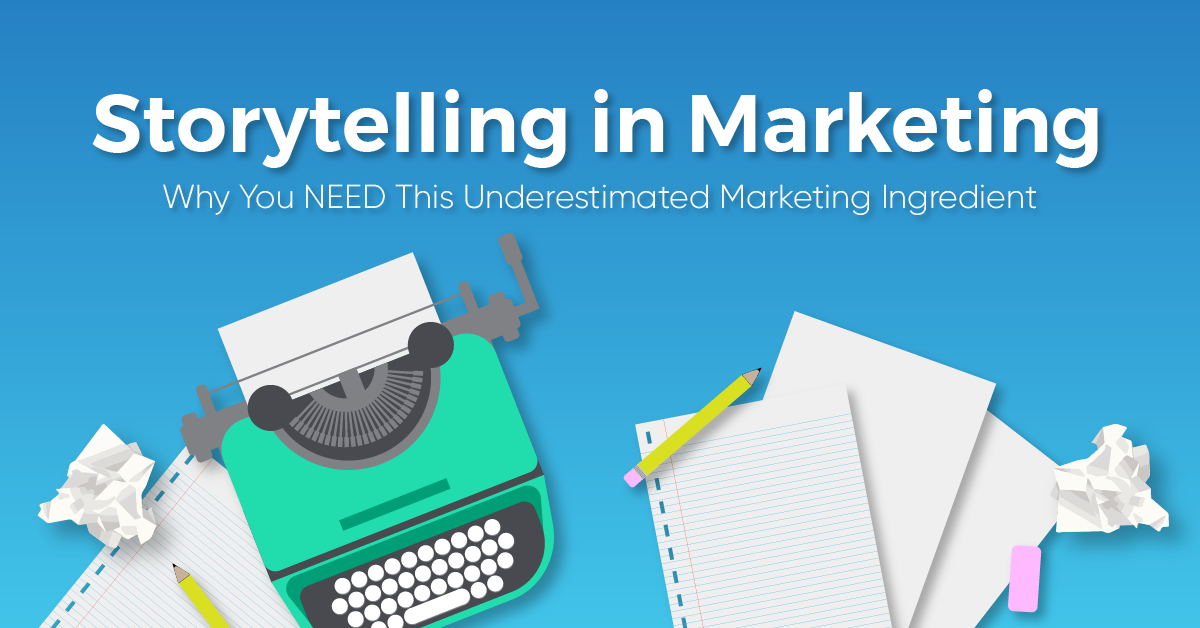Storytelling in Marketing – Why You NEED This Underestimated Marketing Ingredient
The power of storytelling is no fairy tale.
It’s your underestimated marketing ingredient and is one of the most powerful tools your business can use to not only leverage reputation but gain your target audiences’ trust. Whether or not you realize it, your brand is always telling a story to your audience. But is it the right story? The reality is many people are untrained and inexperienced on how to tell a brand story.
Storytelling in marketing can be VERY difficult to implement correctly.
However, just because it’s difficult doesn’t mean it’s impossible. To help you understand storytelling in marketing for your business, this blog post will consist the following:
- Explain the science behind storytelling
- Describe what brand storytelling is
- Show phenomenal examples of successful brand storytelling
- Discuss elements to include in your brand story
- Give other helpful resources about brand storytelling
The science of storytelling
Words are powerful.
They can persuade, entertain and inform individuals. Not only that, but words can also change opinions, perceptions, and realities. Even though the science behind storytelling is rather complicated, we can efficiently sum it up in one sentence: Humans are wired to like stories.
Lifehacks explains:
[ctt template=”9″ link=”ZaXg1″ via=”no” ]“A story, if broken down into the simplest form, is a connection of cause and effect.”[/ctt]
This cause and effect connection is understood as a story, and when humans interpret a story, they automatically relate it to one of their existing experiences. However, since everyone comes from different backgrounds and has had various experiences, this “story” is different for everyone.
This means the challenge for communicators is making sure the intention (and delivery) of their messages are as clear as possible.
This difference in perception leaves the door open for multiple interpretations. It’s paradoxical. Communicators must avoid ambiguity because if they don’t, their business could face serious reputation damage from message misinterpretation. A recent example of this is when the personal care brand, Dove, was accused of racism over their recent advertisement. The science of storytelling proves just how important the choices we make as communicators matters. (Read more here about the controversial Dove ad here)
What is brand storytelling in marketing?
“If you have a really good narrative, you can tell a thousand stories with it.” – Deb Lavoy
Your brand story is more than just a story. It’s the values and messages your business, directly and indirectly, communicates to your audience through storytelling. Storytelling can be seen as both an art and as a science because it’s everything you do, from the colors and texture of your packaging to the staff you hire.
To implement great brand storytelling, every element of your business should somehow reflect the truth about your brand and back to your audience. Remember, brand stories are felt and experienced, not consumed and forgotten.

Examples of successful brand storytelling
All companies can benefit from brand storytelling; it’s not just an element saved for elaborate brands like Apple and John Deere. However, these large companies that have built a name for themselves know a thing or two when it comes to brand storytelling. Here are three examples of companies that have successfully and strategically crafted their brand storytelling for massive success:
1.) Nike
It’s safe to say most people probably think of Nike when they hear the saying, “Just do it.” The company impressively sells around 900 million items of footwear, apparel, and equipment each year and is considered one of the most trustworthy sportswear brands. When it comes to communicating a consistent brand story, few brands have the sustainable track record that Nike does. Nike’s brand storytelling showcases sports as a “universal language” and communicates heroism. These messages have been running for years and have been immensely successful, even winning two Emmy awards for its commercials in 2000 and 2002.
2.) Airbnb
Airbnb is an online marketplace and hospitality service, enabling people to lease or rent short-term lodging. Since the company’s founding in 2008, there have been over 200 million total guest arrivals at Airbnb listings from around the world. Their brand storytelling showcases equality and belongness, and this is heavily demonstrated in their content marketing from their word choices, images, and overall content creation. Airbnb’s 2017 Super Bowl commercial from their campaign “We Accept” communicates these values brilliantly. Likewise, Airbnb’s website copy does this, as well. (See screenshot below)

Airbnb’s word choices (highlighted in yellow) communicate their values of equality and belongness.
3.) Starbucks
Like Seth Godin says,
“Great stories agree with our worldview. The best stories don’t teach people anything new. Instead, the best stories agree with what the audience already believes and make (them) feel smart and secure when reminded how right they were in the first place.”
The global coffee and cafe brand Starbucks perfectly emulates this quote when it comes to their brand storytelling. Their content marketing strategy is focused on sharing who their audience is. This is showcased through their ad, Meet Me at Starbucks, which consists of 220 hours of footage filmed in a single 24-hour period in 59 Starbucks stores in 28 countries by 39 local filmmakers and 10 local photographers.
Elements you need in your brand story
1.) Authenticity
One of the first rules of brand storytelling is authenticity. ALWAYS! “Faking it until you make it” is never a good idea because customers can usually sense inauthenticity a mile away. An example what can be considered an inauthentic advertisement is the 2017 Pepsi Ad featuring Kendall Jenner. The ad sparked accusations that Pepsi’s intention was to appropriate a racial protest movement to sell its product. Even though Pepsi strategy probably came from an authentic place, the advertisement was not received well. It’s safe to say it, unfortunately, missed the mark of authenticity.
2.) Strong brand personality
Brand stories aren’t marketing materials, advertisements or sales pitches. Brand stories are based on a company’s brand persona and brand personality. Just like how writers create personalities for their novel’s characters, business owners should create a personality for their company. Mayven explains, “Brand personality is a set of emotional and associative characteristics connected to a company or brand name.” Creating a brand personality makes it easier for consumers to relate to your business. Remember, humans are wired to like stories, and there are personalities in stories.
3.) Characters your audience will love
Brand storytelling fuels off of relatability. Creating characters your audience will like and cheer for can accomplish that. Keep in mind, your business doesn’t have to create fictional characters or brand mascots in order to tell your stories. However, it is a good idea. A recent example of a company that has done this is Sally Hansen in their new campaign, “Shetopia.”
Shetopia showcases a world in which gender norms cease to exist and features 9 uniquely driven, self-made women who contributed their own real-life experiences to the project. Unlike what majority of companies do, these characters are actually based off of real people. By sharing these character stories, Sally Hansen aims to inspire women around the world to create and embody their own sense of beauty and empowerment.
4.) Structure
Break your stories into a beginning, middle, and end. (Remember when you had to do this back in your high school English class? ) Doing this will help you remember the most important moments of the story, maintain continuity between stories, and control the pacing. Likewise, implementing this structure most importantly makes it easy for your audience to follow along when you’re storytelling. With a clear structure, you can communicate your message much more effectively and can help avoid ambiguity.
[ctt template=”9″ link=”ZaXg1″ via=”no” ]In storytelling, the beginning grabs your audience’s attention, the middle maintains their interest, and the ending wraps the story up nicely and inhibits a possible call to action.[/ctt]
A great example of a story having a beginning, middle, and end is the P&G commercial from the Sochi 2014 Olympic Winter Games, “Thank You, Mom.” The commercial’s beginning shows various children learning how (and struggling) to play sports with their mothers present, the middle shows the children progressing, and the ending shows the now grownup children winning at the 2014 Winter Games. Not only did this commercial play to their audiences’ emotions (I dare you to watch this without tearing up), but it also brilliantly showcased its values in a genuine and an appropriate way.
5.) Suspense
Brand stories should be page turners. You need to leave your audience wanting more. If you do, you’ll have them coming back again and again. Skyward shares, “By releasing episodic content or using teasers on social media to drive audiences back to your website to read more, you tap into their brains need for closure, making them more likely to remember what they read or saw, and more likely to seek out the rest of the story.” Suspense gets your audience’s attention and gives them a reason to return.
6.) “The 20 Keys to a Brand Story”
Bernadette Jiwa explains, “It’s not how good you are. It’s how well you tell your story.”
In her book, The Fortune Cookie Principle: The 20 Keys to a Great Brand Story and Why Your Business Needs One, she highlights 20 keys that help tell your brand story efficiently and effectively. We recommend applying some (if not all) of these 20 keys to your brand story. The information from this book is useful because it explains how you can use brand-building frameworks and communication strategies to help tell your brand’s story from the inside out.

Conclusion
Like Robert McKee says,
“The way to persuade the buyer is to get their attention with a story, and that is very difficult in this day and age of distraction. Story is the most effective way to get attention because what attracts human attention is change.”
In the age of distraction. strive to become the business your audience can’t ignore. You do this with the help of brand storytelling. There’s no doubt that words aren’t powerful. They can persuade, entertain and inform individuals as well as change opinions, perceptions, and realities. In this blog article, we explained the science behind storytelling, described what brand storytelling is, showed phenomenal examples of successful brand storytelling, discussed elements to include in your brand story, and provided other resources.
Storytelling is your most underestimated marketing ingredient. Are you using it to your full advantage?
More resources
- Why brand storytelling is the new marketing: An interview with Robert McKee
- 6 examples of genius brand storytelling you have to see
- 7 ideas for stories to tell about your brand
- Gary Vaynerchuk: Stop Storytelling Like It’s 2007
Let’s chat
Does your business use storytelling to build trust with your audience? Leave your answers in the comments section below!
Ready To Grow?
Let's Talk!


